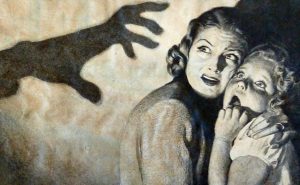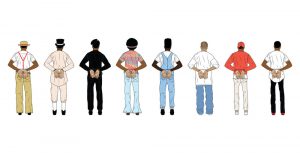Introduction
In the United States, human trafficking has been widely looked at through the lens of sex trafficking, and moreover, the sex trafficking of young white women and girls. This lens allows only a portion of human trafficking to be acknowledged and limits the responses our society deems best. For example, the response to human trafficking – and sex work as a whole – has widely been criminalization of such acts. This may be an appropriate response when the only people affected are affluent white women and girls; however, research shows communities of color and impoverished communities are at a much higher risk of being trafficked, for whom this criminalized response to human trafficking can be particularly harmful.
The Mann Act

The Mann Act resulted in the policing of women’s sexuality and limited the scope of what is seen as human trafficking.
The Mann Act of 1910, also known as the “White Slave Traffic Act,” was passed as a response to the narrative of white slavery. This narrative further perpetuated the idea that there was an evil procurer, typically seen as “foreign,” who would seduce, coerce, lure, trick, or force young white women into brothels far from their homes. This federal statute made it illegal to transport, or to cause the transportation of, women over state lines for the purpose of “prostitution, debauchery, or any other immoral purpose,” which was enforced by the Bureau of Investigations (now, the FBI).
The term “white slavery” created a racialized understanding of female vulnerability and further victimized women and subjected them to sexual surveillance. Furthermore, this term evoked the idea of deviant immigrants coming to the US to exploit white women and use them for sex trafficking. These ideals, combined with the perception of young women who traveled alone to the US as prostitutes, created an anti-immigrant sentiment as a way to protect native-born white women.
Human Trafficking Prominence
As the United States’ first anti-trafficking law, The Mann Act framed how we have come to understand trafficking. Though labor trafficking is likely more prominent in the US and around the world, data collected in regards to human trafficking often does not depict this. In 2017, 8,524 human trafficking cases were reported to the National Human Trafficking Hotline, 6,081 of which were cases of sex trafficking with 1,249 cases of labor trafficking reported. Labor trafficking is most prominent in agriculture, domestic work, and the service industry and our society operates on the backs of the people forcibly working in these industries. This is part of the reason labor trafficking goes under recognized and under reported.

Women and sex workers protesting the “dirty” sentiments associated with and the criminalization of sex work.
Furthermore, sex trafficking is reported more often over labor trafficking due to how our society views sex work and the morality of women. The Mann Act was not just a way to protect people (women) from human trafficking, it was a way to police the sexuality of women. When women and nonbinary people explore their sexuality outside of the privacy of the bedroom, it is seen as “dirty” and “immoral;” when sex work is brought into the conversation, which is usually in the context of women “selling their bodies” to men, it is seen as vile and something only a criminal or dirty woman would do. Therefore, sex trafficking is seen as more heinous and revolting because it involves using a woman’s sexuality, which is already so highly policed, making it easy to report.
Effects on Minorities

An example of the sensationalized posts around the potential sex trafficking white women may face when they are simply out shopping.
Sex trafficking is so highly associated with not just the sexuality of women, but the sexuality of white women and their morality. Still today, stories of white women being followed around department stores by “traffickers” are spread all over social media. These posts are sensationalized and make women, especially middle class, white women, fear for their safety when they leave their homes. Acknowledging sex trafficking is convenient for our society because it can be used as a fear tactic to control women; similarly, ignoring labor trafficking is convenient for our society because we do not have to put time or energy into addressing an issue that disproportionately affects people from low socioeconomic backgrounds and people of color, minority populations.
While human trafficking is usually tied to economics, the ties between poverty, discrimination, and minority status are rarely connected to this economic discussion with human trafficking. Though minority status can often be accepted to mean the community with less people than the “majority,” this is not the case. Heidi Box states “Although minority status is often tied to numerical inferiority, population size is not always a factor; indeed, majority members may experience systemic discrimination on characteristics such as ethnicity, religion, and gender.” Due to this systemic discrimination, these disenfranchised populations typically have few job prospects and limited access to education, which can operate as push factors for many to migrate and be forced into human trafficking as a result. Many will migrate based on a promise from an “employer” that they will have a job as a server, farm worker, domestic worker, or in some other industry, but will then either be refused wages or will be forced into an entirely different industry. All of this is done to ultimately seek economic prosperity they cannot achieve in their current state or country of residence. Evidence collected around human trafficking is suggestive of a link between being a member of a disadvantaged populations and the susceptibility to being trafficked, yet this trend has had little to no investigation because it is easier for dominant culture to ignore this trend. Unsurprisingly, ignoring this trend has created a response to human trafficking that only works for a portion of the victims.
Response to Human Trafficking
The US Department of State states, “Combating human trafficking requires a comprehensive, multidisciplinary effort. Within government, this means the participation and coordination among agencies with a range of responsibilities that include criminal enforcement, labor enforcement, victim outreach and services, public awareness, education, trade policy, international development and programs, immigration, intelligence, and diplomacy.” Criminal enforcement is the first of several approaches to human trafficking listed by the government’s website and Antonio Guterres, Secretary-General of the United Nations stated during a Security Council meeting in 2017 that more can be done to prevent and punish crime. The idea that prosecution will somehow deter or stop human trafficking is one that persists, despite the fact there is little evidence that prosecutions has any significant impact on human trafficking as a whole. As David Feingold of Foreign Policy puts it, the nature of human trafficking makes it nearly impossible for prosecutions to have any sort of impact on the large scale because it is typically just local recruiters or transporters that will prosecuted.
Furthermore, the process of seeking a conviction of a trafficker can be especially harmful toward victims of trafficking, specifically when the victim in a member of a minority population. In order for a victim to seek a conviction, they must first accept, or be convinced, they are a vicim which can be a difficult process and can be emotionally tolling on the victim. Once this is accomplished, the victim has to then face their trafficker in court, who may have also been their abuser, and rehash all the trauma they may have faced while they were being trafficked.

People of color are incarcerated at nearly twice the rate of white people.
This process can certainly be traumatic for any victim of trafficking, but the trauma is only greater for people of minority populations. The US has been incarcerating people by the masses in the last thirty years and people of color make up the majority of the prison population. Hispanic people make up 16% of the US population, yet account for 19% of the prison population, while black people make up 13% of the US population and 40% of the prison population. Due to the fact that people of color are so easily and thoughtlessly thrown into prison, the people of color who are trafficked are apprehensive to seek help from the police for fear of being taken into custody themselves. Additionally, they may be scared to report their trafficker if their trafficker is a person of color because their community may blame them for putting yet another member of their community behind bars. Ultimately, this carceral approach is harmful to the populations most vulnerable and at risk for human trafficking.
Another common approach to combating human trafficking is to tighten borders since migration is typically an aspect of human trafficking. However, this approach causes the opposite of the intended effect. Human trafficking actually increases because those who try to migrate to seek economic prosperity or to escape violence in their country of origin will now turn to smugglers because they still need to leave. Paying a smuggler to get them to their desired destination leaves them at risk to more exploitation, which can lead to human trafficking.
Conclusion
Though impoverished communities and communities of color are the most at risk of being trafficked, this correlation has not been investigated or researched, and as such, our responses to human trafficking do not benefit victims. In fact, the most prominent approaches to human trafficking work to harm those at risk. Therefore, the trend between minority status and risk for human trafficking needs to be investigated to create a response that works for the majority of trafficking victims.